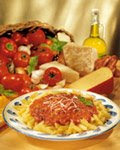
Ingredients:
2 fresh crabs approximately 500 g each
1/2 cup pPlain flour
1/4 cup cooking oil
1 medium finely chopped onion
5 cm fresh ginger finely grated
4 cloves finely chopped garlic
5 red chilies, finely chopped
2 cups bottled tomato pasta sauce
1 cup water
2 tablespoons soy sauce
2 tablespoons sweet chili sauce
1 tablespoon rice vinegar
2 tablespoons soft brown sugar
Method:
*Wash the crabs well and scrub the shell.
*Using a large cleaver, cut the crabs in half and rinse well under cold water, carefully removing the yellow gills or spongy parts.
*Hit the legs and larger front nippers with the flat side of the cleaver to crack the shell. This is to make the eating process easier.
*Lightly and carefully coat the shells with a little flour.
*Heat about 2 tablespoons cooking oil in a large wok and cook 1 1/2 crab at a time, carefully turning and holding the crab in the hot oil until the shell just turns red.
*Repeat with the remaining crab halves.
*Add the remaining oil to the wok and cook the onion, ginger, garlic and chili for 5 minutes over medium heat and stirring regularly.
*Add the tomato sauce, water, soy sauce, chili sauce, vinegar and sugar. Bring to boil and cook for 15 minutes.
*Return the crab to the wok and simmer, turning carefully in the sauce for 10 minutes or until the crab meat turns white.
*Do not overcook.
*Serve with steamed rice.
Note : It is important that you use only freshly caught crabs.



















